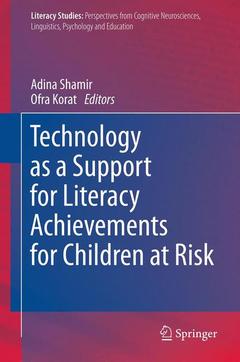Description
Technology as a Support for Literacy Achievements for Children at Risk, 2013
Literacy Studies Series, Vol. 7
Coordinators: Shamir Adina, Korat Ofra
Language: English
Keywords
Assessment to Instruction (A2i); Brain imaging technology; Children with learning disabilities; Early literacy skills; Literacy interventions using ICT in children with SLI; Low-SES children; Reading e-books and printed books; Support for at-risk students; Teaching literacy to children at risk
Publication date: 12-2014
238 p. · 15.5x23.5 cm · Paperback
Publication date: 11-2012
238 p. · 15.5x23.5 cm · Paperback
Description
/li>Contents
/li>Comment
/li>
Introduction: Technology as a Support for Literacy Achievements for Children at Risk .-Early Childhood 1. Effects of an Adaptive Game on Early Literacy Skills in At Risk Populations .- 2. Giving All Children a Good Start: The Effects of an Embedded Multimedia Intervention for Narrowing the Vocabulary Gap Before Kindergarten .- 3. Video Storybooks – A Way to Empower Children at Risk .- 4. Print to Pixel: Foundations of an E-Book Instructional Model in Early Literacy .- 5. What Can Better Support Low SES Children’s Emergent Reading? Reading E-Books and Printed Books with and without Adult Mediation .- 6.The Effects of Multimedia on Early Literacy Development of Children at Risk: A Meta-Analysis .- School Children 7. Teachers’ Use of Assessment to Instruction (A2i) Software and Third Graders’ Reading Comprehension Gains .- 8. An Online Learning Community as Support for A1- Risk Students’ Literacy Growth-Findings, Implications, and Challenges .- 9. Stimulating Self-regulated Learning in Hypermedia to Support Mathematical Literacy of Lower-achieving Students .- Special Educational Needs 10. Promoting Emergent Literacy of Children at Risk for Learning Disabilities: Do E-books Make a Difference? .- 11. Early Literacy Interventions using ICT in Children with SLI .- 12. Making a Difference: Using Laptops as a Support for Spelling Improvement among Students with Learning Disability .- 13. Nonliteral Comprehension Deficits in Children with Learning Disabilities: Implications of Brain Imaging Technology .- 14. Use of Technology for Literacy Acquisition among Children with Communication Difficulties.




